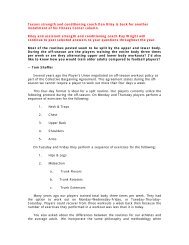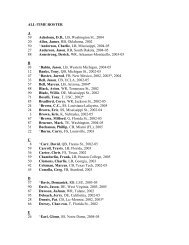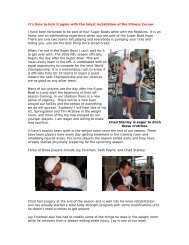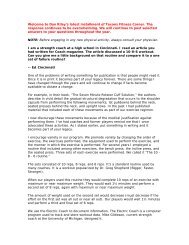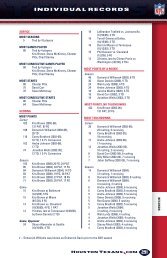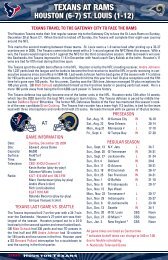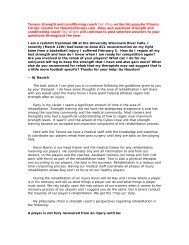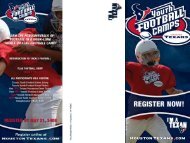HOUSTON TEXANS STRENGTH & CONDITIONING PROGRAM ...
HOUSTON TEXANS STRENGTH & CONDITIONING PROGRAM ...
HOUSTON TEXANS STRENGTH & CONDITIONING PROGRAM ...
You also want an ePaper? Increase the reach of your titles
YUMPU automatically turns print PDFs into web optimized ePapers that Google loves.
Stretching is a low intensity exercise used to increase flexibility. The amount of time<br />
you spend stretching should be proportionate to your degree of flexibility (or lack of).<br />
Some athletes are naturally blessed with a high degree of flexibility and some are not.<br />
Stretching is not a warm-up. An exercise is considered a warm-up if core body<br />
temperature is increased by two degrees or you break a sweat at room temperature.<br />
Stretching does neither. Stretch to become more flexible, not to warm up. Perform<br />
appropriate activities to warm up and then stretch.<br />
The best activity you can use to warm up is the activity itself. If you’re going to run<br />
pass routes all out, begin running slowly and gradually increase your speed. Stretching<br />
will not warm you up to run pass routes all out.<br />
There are a large number of stretching exercises to choose from. Like any other form<br />
of exercise, it must be performed with some regularity. Select a group of exercises<br />
designed to stretch the major muscles in the upper and lower body.<br />
Use the following guidelines while stretching:<br />
* Do not bounce<br />
* Stretch statically (hold the stretched position without bouncing)<br />
* Place the muscle into a position where you feel a mild stretch<br />
* Hold that position for 10 - 30 seconds<br />
* Accelerated breathing and a burning sensation are signs of over stretching<br />
The specific movements you perform on the field will develop the range of<br />
motion of the muscles used to perform those activities. You develop a range of<br />
motion while performing a stretching exercise that is specific to that stretch, and the<br />
limited number of fibers recruited at that point.<br />
The range of motion of the muscles used to play the game of football is radically<br />
different from the range of motion developed from stretching. Other differences include<br />
the number of muscle fibers recruited, the violence of the movements, and the many<br />
different arcs the muscles use to change direction, stop, and backpedal.<br />
This phenomenon can be observed in the off-season while running on the treadmill.<br />
Run intervals at 10 mph each day until your muscles adapt to this speed and range of<br />
motion. You’ll experience a new soreness in the legs when the speed is increased to 11<br />
mph. This small increase in speed will increase the range of motion of your stride and is<br />
enough to take your muscles through a new range of motion. The same soreness occurs<br />
when you increase the speed to 12 mph.<br />
You’ve spent weeks stretching and running at slower speeds. Soreness wasn’t<br />
experienced until you forced your muscles through a new range of motion. It is not lactic<br />
acid accumulation if only a few reps were performed. It is the soreness from stretching<br />
the muscle beyond its current range of motion.<br />
Play basketball and a new soreness is experienced. Change activities (racquetball)<br />
and there’s a new range of motion and soreness. Go to summer camp and the range of<br />
motion to cover receivers, run pass routes, and rush the passer, will demand a new range<br />
of motion and soreness. After several days, your muscles will adapt to the violent range<br />
of motion these movements require.<br />
Regardless of how much you stretch or how flexible you are, you’ll experience this<br />
new soreness each time you perform a new activity that takes your muscles through a<br />
Anding/Riley/Wright 47



